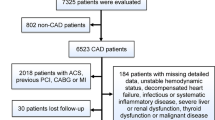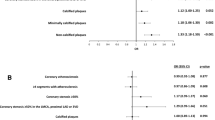Abstract
Coronary heart disease (CHD) is the leading cause of death in the industrialized world. Recent laboratory and clinical studies have shown that inflammation plays a pivotal role in the inception, progression, and destabilization of atheromas. The acute-phase reactant C-reactive protein (CRP) has been shown to reflect systemic and, perhaps, vascular inflammation and to predict future cardiovascular events in asymptomatic individuals. The relative risk associated with CRP is independent of other cardiovascular disease risk factors. High-sensitivity assays (hs-CRP) are needed for the measurement of CRP concentration for the purpose of predicting the risk of future coronary events. Available assays must be standardized because patients' results will be interpreted using population-based cutpoints. An algorithm for risk stratification incorporating hs-CRP and total cholesterol to high-density lipoprotein cholesterol ratio has been developed. Statin class drugs and aspirin appear to modulate CHD risk in those with increased hs-CRP concentration. Several prospective studies, are now underway to specifically develop novel clinical utilities and therapeutic strategies for hs-CRP.
Similar content being viewed by others
References
Ross, R. (1999). Atherosclerosis—an inflammatory disease [see comments] N. Engl. J. Med. 340:115–126.
Libby, P., and Ridker P.M. (1999). Novel inflammatory markers of coronary risk: theory versus practice [editorial; comment]. Circulation 100:1148–1150.
Kuller, L.H. Tracy, R.P., Shaten, J., and Meilahn, E.N. (1996). Relation of C-reactive protein and coronary heart disease in the MRFIT nested case-control study. Multiple Risk Factor, Intervention Trial. Am. J. Epidemiol. 144: 537–547.
Ridker, P.M., Cushman, M., Stampfer, M.J., Tracy, R.P., and Hennekens, C.H. (1997). Inflammation aspirin, and the risk of cardiovascular disease in apparently healthy men [published erratum appears in N. Engl. J. Med. 337(5): 356] [see comments]. N. Engl. J. Med. 336:973–979.
Tracy, R.P., Lemaitre, R.N., Psaty, B.M., Ives, D.G., Evans, R.W., Cushman, M., et al. (1997). Relationship of C-reactive protein to risk of cardiovascular disease in the elderly. Results from the Cardiovascular Health Study and the Rural Health Promotion Project. Arterioscler. Thromb. Vasc. Biol. 17:1121–1127.
Koening, W.; Sund, M., Frohlich, M., Fisher, H.G., Lowel, H., Doring, A., et al. (1999). C-Reactive protein, a sensitive marker of inflammation, prediects future risk of coronary heart disease in initially healthy middle-aged men: results from the MONICA (Monitoring Trends and Determinants in Cardiovascular Disease) Augsburg Cohort Study, 1984 to 1992. Circulation 99: 237–242.
Ridker, P.M., Hennekens, C.H., Buring, J.E., and Rifai, N. (2000). C-reactive protein and other markers of inflammation in the prediction of cardiovascular disease in women. N. Engl. J. Med. 342: 836–843.
Roivanen, M., Viik-Kajander, M., Palosuo, T., Toivanen, P., Leinone, M., Saikko, P., et al. (2000). Infections, inflammation, and the risk of coronary heart disease. Circulation 101:252–257.
Danesh J., Whincup, P., Walker, M., Lennon, L., Thomson, A., Abbleby, P., et al. (2000). Low grade inflammation and coronary heart disease: prospective study and updated meta-analyses [see comments]. Br. Med. J. 321:199–204.
Mendall, M.A., Strachan, D.P., Butland, B.K., Ballam, L., Morris, J., Sweetnam, P.M., et al. (2000). C-Reactive protein: relation to total mortality, cardiovascular mortality and cardiovascular risk factors in men. Eur. Heart J. 21: 1584–1590.
Rifai, N., Tracy, R.P., and Ridker, P.M. (1999). Clinical efficacy of an automated high-sensitivity C-reactive protein assay. Clin. Chem. 45:2136–2141.
Ridker, P.M., Cushman, M., Stampfer, M. J., Tracy, R.P., and Henekens, C.H. (1998). Plasma concentration of C-reactive protein and risk of developing peripheral vascular disease [see comments]. Circulation 97:425–428.
Ridker, P.M., Glynn, R.J., and Hennekens, C.H. (1998). C-Reactive protein adds to the predictive value of total and HDL cholesterol in determining risk of first, myocardial infarction [see comments]. Circulation 97:2007–2011.
Rifai, N. and Ridker, P.M. (2001). Proposed cardiovascular risk assessment algorithm using high-sensitivity C-reactive protein and lipid screening. Clin. Chem. 47:28–30.
Ridker, P.M., Rifai, N., Pfeffer, M.A., Sacks, F.M., Moye, L.A., Goldman, S., et al. (1998). Inflammation, pravastatin and the risk of coronary events after myocardial infarction in patients with average cholesterol levels Cholesterol and Recurrent Events, (CARE) Investigators. Circulation 98:839–844.
Ockene, I.S., Rifai, N., Ridker, P.M., Reed, G., and Stanek, E. (2001). Variability and classification accuracy of serial high-sensitivity C-reactive protein measurements in healthy adults. Clin. Chem. 47:444–450.
Ikonomidis, I., Andreotti, F., Economou, E., Stefanadis, C., Toutouzas, P., and Nihoyannopoulos P. (1999). Increased proinflammatory cytokines in patients with chronic stable angina and their reduction by aspirin. Circulation 100:793–798.
Ridker, P.M., Rifai, N., Pfeffer, M.A., Sacks, F., and Braunwald, E. (1999). Long-term effects of pravastatin on plasma concentration of C-reactive protein. The Cholesterol and Recurrent Events (CARE) Investigators Circulation 100:230–235.
Roberts, W.L., Moulton, L., Law, T., Farrow, G., Cooper-Anderson, M., Savory, J., et al. (2001). Evaluation of nine automated high-sensitivity C-reactive protein methods: implications for clinical and epidemiological applications. Part 2. Clin. Chem. 47:418–425.
Author information
Authors and Affiliations
Rights and permissions
About this article
Cite this article
Rifai, N. C-reactive protein and coronary heart disease. Cardiovasc Toxicol 1, 153–157 (2001). https://doi.org/10.1385/CT:1:2:153
Issue Date:
DOI: https://doi.org/10.1385/CT:1:2:153




